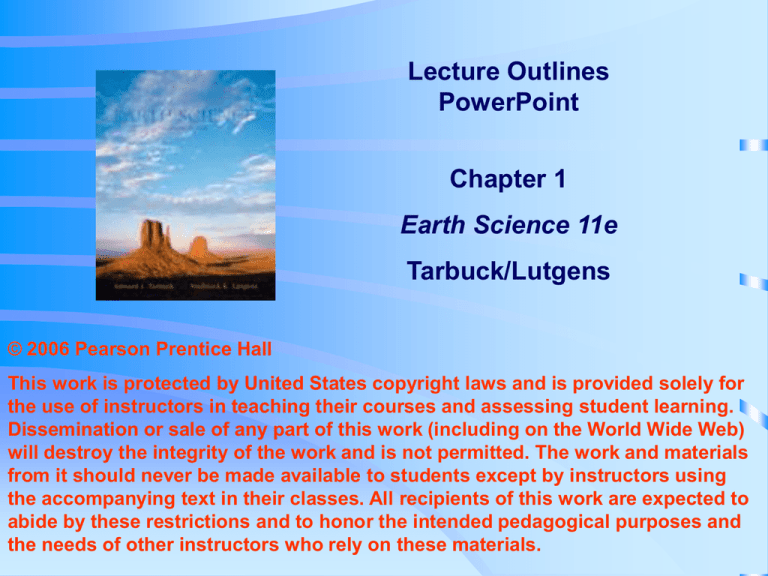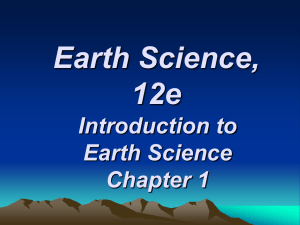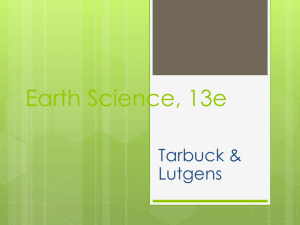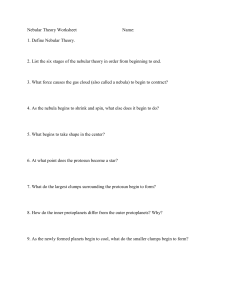
Lecture Outlines
PowerPoint
Chapter 1
Earth Science 11e
Tarbuck/Lutgens
© 2006 Pearson Prentice Hall
This work is protected by United States copyright laws and is provided solely for
the use of instructors in teaching their courses and assessing student learning.
Dissemination or sale of any part of this work (including on the World Wide Web)
will destroy the integrity of the work and is not permitted. The work and materials
from it should never be made available to students except by instructors using
the accompanying text in their classes. All recipients of this work are expected to
abide by these restrictions and to honor the intended pedagogical purposes and
the needs of other instructors who rely on these materials.
Earth Science, 11e
Introduction to
Earth Science
Chapter 1
Earth Science
Encompasses all sciences that seek to
understand
• Earth
• Earth's neighbors in space
Earth Science includes
• Geology - literally the “study of Earth”
• Oceanography – a study of the ocean
Earth Science
Earth Science includes
• Meteorology - the study of the atmosphere and
the processes that produce weather
• Astronomy - the study of the universe
People and the environment
Environment
• Surrounds and influences organisms
• Physical environment encompasses water, air,
soil, and rock
• Term “environmental” is usually reserved for
those aspects that focus on the relationships
between people and the natural environment
People and the environment
Resources
• An important focus of the Earth sciences
• Includes water, soil, minerals, and energy
• Two broad categories
• Renewable – can be replenished (examples include
plants and energy from water and wind)
• Nonrenewable – metals (examples include metals
and fuels)
People and the environment
Population
• Population of the planet is growing rapidly
• Rate of mineral and energy usage has climbed
more rapidly than the overall growth of
population
Environmental problems
• Local, regional, and global
People and the environment
Environmental problems
• Human-induced and accentuated
•
•
•
•
Urban air pollution
Acid rain
Ozone depletion
Global warming
• Natural hazards
• Earthquakes
• Landslides
People and the environment
Environmental problems
• Natural hazards continued
• Floods
• Hurricanes
• World population pressures
Scientific inquiry
Science assumes the natural world is
• Consistent
• Predictable
Goal of science
• To discover patterns in nature
• To use the knowledge to predict
Scientific inquiry
An idea can become a
• Hypothesis (tentative or untested explanation)
• Theory (tested and confirmed hypothesis)
• Paradigm (a theory that explains a large number
of interrelated aspects of the natural world)
Scientific method
• Gather facts through observation
• Formulate hypotheses and theories
Scientific inquiry
Scientific knowledge is gained through
• Following systematic steps
•
•
•
•
Collecting facts
Developing a hypothesis
Conduct experiments
Re-examine the hypothesis and accept, modify, or
reject
• Theories that withstand examination
• Totally unexpected occurrences
Early evolution of Earth
Origin of Earth
• Most researchers believe that Earth and the
other planets formed at essentially the same
time
• Nebular hypothesis
• Solar system evolved from an enormous rotating
cloud called the solar nebula
• Nebula was composed mostly of hydrogen and
helium
Early evolution of Earth
Origin of Earth
• Nebular hypothesis continued
• About 5 billion years ago the nebula began to
contract
• Assumes a flat, disk shape with the protosun (preSun) at the center
• Inner planets begin to form from metallic and rocky
clumps
• Larger outer planets began forming from fragments
with a high percentage of ices
The Nebular hypothesis
Figure 1.7
Early evolution of Earth
Formation of Earth’s layered structure
• As Earth formed, the decay of radioactive
elements and heat from high-velocity impacts
caused the temperature to increase
• Iron and nickel began to melt and sink toward the
center
• Lighter rocky components floated outward, toward
the surface
• Gaseous material escaped from Earth’s interior
to produce the primitive atmosphere
Earth's “Spheres"
Hydrosphere
• Ocean – the most prominent feature of the
hydrosphere
• Nearly 71% of Earth's surface
• About 97% of Earth's water
• Also includes fresh water found in streams,
lakes, and glaciers, as well as that found
underground
Earth's “Spheres"
Atmosphere
• Thin, tenuous blanket of air
• One half lies below 5.6 kilometers (3.5 miles)
Biosphere
• Includes all life
• Concentrated near the surface in a zone that
extends from the ocean floor upward for several
kilometers into the atmosphere
Earth's “Spheres"
Solid Earth
• Based on compositional differences, it consists
of the crust, mantle, and core
• Divisions of the outer portion are based on how
materials behave
• Lithosphere - rigid outer layer
• Divisions of Earth’s surface - continents and ocean
basins
Earth’s layered structure
Earth system science
Earth is a dynamic body with many separate
but highly interacting parts or spheres
Earth system science studies Earth as a
system composed of numerous parts, or
subsystems
System - any size group of interacting parts
that form a complex whole
Earth system science
System
• Closed systems are self-contained (e.g. an
automobile cooling system)
• Open systems - both energy and matter flow
into and out of the system (e.g. a river system)
Earth system science
Feedback mechanisms
• Negative-feedback mechanisms resist change
and stabilize the system
• Positive-feedback mechanisms enhance the
system
Earth as a system
• Consists of a nearly endless array of
subsystems (e.g. hydrologic cycle, rock cycle)
Earth system cycles
Figure 1.17
Earth system science
Earth as a system
• Sources of energy
• Sun – drives external processes such as weather,
ocean circulation and erosional processes
• Earth’s interior – drives internal processes including
volcanoes, earthquakes and mountain building
• Humans are part of the Earth system
End of Chapter 1




